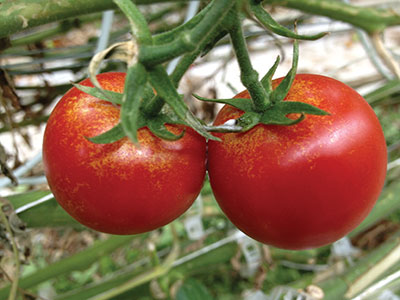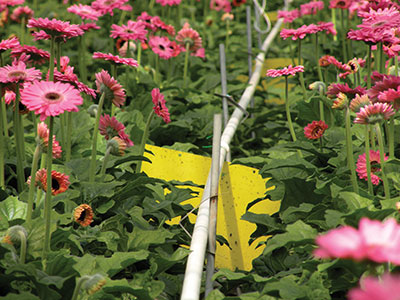
Western Flower Thrips (WFT) is one of the most common and major pests in the cut flower and greenhouse vegetable industry.
Western Flower Thrips (WFT) is one of the most common and major pests in the cut flower and greenhouse vegetable industry.
 |
|
| Damage on tomatoes appears as yellow stipling, usually near the calyx. PHOTO COURTESY CROP DEFENDERS Advertisement
|
It causes damage to flower buds and growing points, which decreases production and makes many flowers unmarketable.
In many common cut flowers, such as roses, gerberas and chrysanthemums, it can cause discoloration, wilting and scarring that can distort plant growth and result in imperfect flowers that cannot be marketed.
In greenhouse vegetables, the effects of WFT on the fruit can vary widely. For example, in the greenhouse cucumber, WFT can produce scarring on young fruits causing the cucumber to curl as it grows. In tomato crops, the damage appears as yellow stipling, usually near the calyx of the fruit, and if damage is severe, the fruit cannot be marketed to stores.
DIFFERENT LIFECYCLE STAGES HAVE VARYING EFFECTS
Different lifecycle stages of the WFT can also have varying effects on a variety of vegetables and flowers.
The larval stages of thrips feed on leaf, flower and fruit tissue causing much of the damage mentioned previously.
However, thrips can also lay their eggs in leaf and fruit tissue, which creates exit holes when the larvae hatch. This type of damage is easy to identify in many vegetables, such as tomatoes and peppers, as they appear as discoloured spots.
PREDATORY MITES ARE EFFECTIVE
WFT can be controlled using a variety of biological control agents. Predatory mites, like Amblyseius swirskii and Amblyseius cucumeris, feed on eggs and the first larval stage of thrips and are common in both industries.
A. cucumeris is a less aggressive predator and tends to be used more as a preventive measure than A. swirskii, which can be added in loose form as a curative action.
The second larval stage and adult thrips can be controlled by the pirate bug Orius insidiosus, or Orius.
This predator is sensitive to photoperiod, or light duration, and it can enter into a diapaused state when the photoperiod is too short. Therefore, it cannot be used in the winter months of the year, as Orius will not feed when diapaused.
CONTROL AT THE PUPAL STAGES
As for the pupal stages, which often fall to the ground, a soil-dwelling mite, such as hypoaspis miles (Stratiolaelaps scimitus) and/or nematodes (Steinerema feltiae) can be added to soil or cocoa medium to minimize the number of thrips that emerge.
NEW CONTROL TECHNIQUE NOW BEING APPLIED WITH GOOD SUCCESS
A newer technique used in the application of nematodes, “sprenching,” can be a more economic way of controlling thrips.
With sprenching, instead of applying the nematodes deep into the soil, only the top two inches or so are drenched with the nematodes. This will give growers the same effects as traditional drenching while using less material. However, sprenching needs to be conducted regularly to keep thrips pupae under control.
Using sticky cards and sticky tape in cut flowers can also help to minimize thrips while conserving finances. Hanging large sticky cards near entrances and exits can help to trap thrips before they reach fruits and flowers.
STICKY TAPE PLACED JUST ABOVE THE CROP
Hanging lines of sticky tape, no more than six inches above the crop, can catch thrips that are already in the greenhouse. Thrips are not strong flyers, and therefore they cannot travel large distances; this is why sticky cards and tape need to be hung close to the crop.
 |
|
| Sticky card in cut flower crop.
|
However, if Orius is introduced, then blue sticky cards should be used instead of yellow. Both colours attract the same amount of thrips, while blue is less attractive to Orius.
Therefore, by switching colours, accidentally trapping biological control agents can be minimized.
THE EFFECT OF THE WEATHER
Another important note about thrips is that they are positively affected by thunder. During thunderstorms, according to observations, thrips are capable of flying greater distances than under normal weather conditions.
Therefore, if the forecast predicts a storm, hanging sticky tape and cards can trap more thrips and prevent their spread, which tends to be aided by these events.
IN CONCLUSION
WFT can be a very harmful pest if left untreated in both the cut flowers and greenhouse vegetable market. They have the potential to cause significant economic harm to growers through the decreased production and loss of marketable fruits and flowers. However, WFT can be controlled biologically and physically, especially if the infestation is caught early, by a variety of agents that are commercially available and easily applied.
Amanda Eyraud M.Sc., is Eco-Biologist and Technical Service Representative for Crop Defenders Ltd.
Print this page